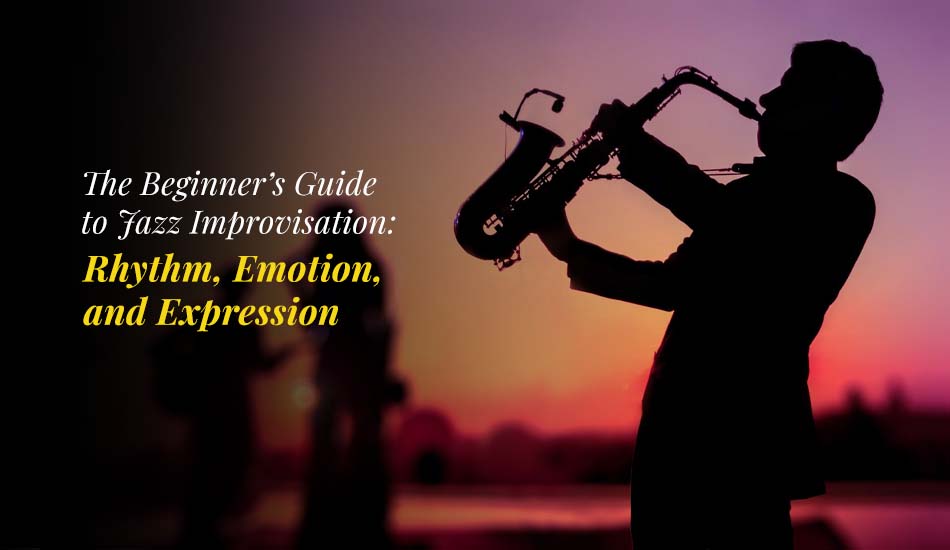Introduction
Jazz has always been more than just a genre, it’s a conversation, a feeling, and for many people mystery. At the heart of this mystery lies jazz improvisation, a musical language spoken by musicians on stage in real time. One may at first think find it spontaneous or even chaotic, but behind those impromptu solos is an incorporation of harmony, rhythm and storytelling. We are translating jazz’s secret code, so you can easily learn & improvise jazz, and bring it to life!
What Makes Jazz Improvisation Different?
Compared with classical music, where works are fixed, jazz lives off being free. Jazz improvisation lets musicians express themselves with real-time musical decisions. It’s the art of building on a structure while breaking the rules, creating new renditions of one piece every time you play it. This is what makes jazz different from anything else and what makes each performance an individual experience.
The Basic Elements of Improvisation
For the beginner, improvisation can be boiled down to the following:
- Scales and Modes: These are the handful of common scatter-shot phrases that teach a musician called “the raw materials” from which he finds his own, maybe a dozen or two it depends on what scale and mode he in particular uses. All successful musicians use this same technique to great effect.
- Chord Progressions: These put structure into a piece and therefore act as a “route map” for improvisation.
- Rhythm and Feel: Timing, swing and groove are all vital to shaping the context (character) of the solo.
- Listening and Interaction: Great jazz improvisers are adept listeners who will often answer and work from their bandmates in the moment.
If you have listened to instrumental music like the original soundtrack of a signature music album such as “Kind of Blue” or any live recording from new jazz releases in 2025, you’ll notice how each artist speaks their own dialect.
How Musicians Communicate on Stage
One of the most magical aspects of jazz is its collaborative nature. When performing onstage, the musician relies neither on verbal language nor even notes there and then he uses eye contact, body expression and musical sentences.
So for example, a pianist might play a phrase and then the saxophonist will echo it with a variation of his own. Changing the groove slightly, the drummer may suggest to the bassist next. What has occurred this musical conversation is not a result of rehearsals into the uneasy commonplace. It is based on shared knowledge and respect for jazz.
Typical Myths About Jazz Improvisation
Unfortunately, many people believe the following myths:
- “I’m just playing by accident.” Jazz improvisation is actually structured in theory and practice up to a point. While it may sound spontaneous, it’s often the result of years of accumulated art.
- “Talent has to be inborn for this.” Talent helps. However, jazz improvisation is a skill. One that can be developed by anyone who studies hard enough and uses good guidance.”
- “You need to know every scale and chord.” Time produces the level of skill which is achieved, but many of the truly great solos are made using basic ideas that have been repeated and refined with feeling.
How to Enjoy Jazz Improvisation (Even if You’re New to the Genre)
If you’re new to jazz, there are several things you can do:
Take a single distinct instrument as your focus and follow its part throughout the song. Look for the main theme (head). Listen to how this melody unfolds throughout the song. Watch the group. How did players come in and out? How did they blend their ideas?
In a listening room like at signature music artist Sylvia Brooks or other high-profile jazz releases 2025, you can enjoy the subtle beauty of improvisation.
Suggestions for Beginners Who Want to Try Improvising
For those musicians who want to make a start on improvising, especially beginners, I offer the following suggestions for your perusal as well:
- Use an imitative mode rather than an original one while you are learning – Learn solos that your favorite artists have put together so that you will have ideas and a style of phrasing that mirrors theirs!
- Simplify it – Focus on melody and rhythm before adding complexity.
- Record yourself – The best route to progress is in its own voice playback.
Practice with the help of backing tapes. Making use of this technique helps to do away with some of the anxiety which people feel when they have to face an audience live.
Conclusion
After all, Jazz improvisation is not just an art form; it is a way for one generation to communicate with another. If you are a listener or musician in this music, then knowing its language will help you appreciate it all the more deeply as well human contact is guaranteed. From the unsung heroes of a classic record to the newcomers on top at the turn of each decade, this is exactly what keeps jazz special. Just keep listening and enjoying (and maybe even performing): there’s nothing like learning the language of jazz today!




